How to Write a Procedure From Scratch [in 8 Steps]
Last Updated on December 12, 2023 by Owen McGab Enaohwo

Think of a business as a fleet of ships navigating through uncharted waters. Procedures are like detailed maps, ensuring each ship reaches its destination safely and efficiently. However, what happens when these maps are vague or incomplete? Each captain relies on guesswork, leading to chaos.
This lack of clear direction jeopardizes individual ships and puts the entire fleet’s success at risk. The same happens when procedures are poorly written. They lead to misunderstandings, inefficiencies, and errors, all of which significantly affect productivity and, consequently, the company’s bottom line.
This article will equip you with the skills to craft procedures from scratch, breaking down the process into eight essential steps.
Your business needs a tool like SweetProcess to write and streamline its procedures. Sign up for a 14-day free trial to see how it works. No credit card is required!
How to Write a Procedure – Content Guide:
How to Write a Procedure: Step-by-Step Guide
How to Create and Manage Procedures Using SweetProcess
5 Questions to Answer Before Writing a Procedure
What to Do After Writing a Procedure
Benefits of Well-Written Procedures in an Organization
Great Procedures Make Outstanding Businesses
What Is a Procedure?

A procedure is a step-by-step instruction and actions designed to achieve a specific task or goal.
It outlines the sequence of actions to be taken, specifying who should perform them and when. They ensure tasks are carried out efficiently, consistently, and safely.
You can update procedures regularly and add new details or more steps. They are usually presented in a visual flowchart or written SOP document to guide the team.
For instance, a simple procedure for handling customer inquiries via email can be:
- Check the company email for inquiries.
- Take note of any specific details mentioned in the email.
- Analyze the inquiry and gather necessary information if needed.
- Draft a clear and polite response addressing the customer’s query.
- Review the response to ensure it is professional, concise, and free of errors.
- Click “Send” to reply to the customer’s email promptly.
Similar to procedures, standard operating procedures (SOPs) are detailed documents that provide specific instructions to complete routine operations. While procedures are broader and can encompass various organizational tasks, SOPs are typically more specific, focusing on standardized processes within a particular department or for a specific activity.
A standard operating procedure often includes more detailed guidelines, quality standards, and compliance requirements, ensuring uniformity. They aim to ensure that employees adhere to regulations and avoid mistakes in their daily tasks.
How to Write a Procedure: Step-by-Step Guide

Writing procedures require you to document business processes or outline a step-by-step guide for a specific task. This section provides a comprehensive, step-by-step guide to help you master the art of procedural writing.
Step 1: Choose a Good Title
A title acts as an identifier for your procedure. You need to make it easy for your team and other relevant stakeholders to find the documented procedure. The title should be clear, concise, and descriptive, summarizing the procedure’s purpose.
A well-chosen title provides immediate insight, guiding users on the procedure’s content and relevance. It should use simple language and keywords relevant to the task, making it easily searchable. For instance, if the procedure is about “how to send an invoice”, the title should have the keyword “invoice.”
This approach boosts searchability and encourages users to engage with the procedure.
Step 2: List the Relevant Materials
Once you have the title, identify and document all the materials necessary to execute the procedure successfully. This comprehensive list should encompass tools, equipment, software, documents, and other resources essential for the task.
For instance, if your procedure is about setting up a printer, your materials will include the downloadable software, A4 or letter-sized paper, ink or toner cartridges, and power cords.
As you list the materials, consider the diverse needs of your audience. You should have a detailed material list accommodating new hires and experienced employees. If applicable, mention safety equipment, ensuring the procedure is executed safely. Regularly update this list to reflect changes in technology or processes.
Step 3: Highlight the Steps for Performing the Procedure
Now that you are ready to write the procedural text, you need to break it down into clear and concise steps. Each step should be specific, action-oriented, and ordered logically. At this stage, you can just list the tasks to make it easy for your employees to read through.
Use simple language and avoid jargon to make it easy to understand. For instance, if your procedure involves editing a blog post, include steps like “check grammar” and “check titles and subheadings.” These sub-steps are important for the team responsible for task execution. In addition, ensure that the steps are not ambiguous to avoid confusion. You don’t need to go into detail here so that anyone can understand the steps at a glance.
Step 4: Describe the Highlighted Steps
Using the list in step 3, you can now go a bit deeper. Provide detailed explanations, context, and relevant tips or warnings for each step. To avoid confusion, give your team more information about each step.
Let’s say the step is to check the grammar on your blog post. Your explanation can include these details.
- Check the sentence structures, ensuring they are coherent and error-free.
- Look out for correct punctuation.
- Run the blog post through a grammar tool or software to catch errors.
- Preview changes before publishing.
Step 5: Include Tips, Advice, and Warning
Just because you have provided the procedure steps, it doesn’t mean that there won’t be any errors. However, you can minimize these errors by incorporating valuable tips, advice, and warnings into your procedure. These tips enhance user understanding and safety.
You can provide shortcuts, best practices, or suggestions for smoother execution or more context, explaining the reasoning behind specific steps. Additionally, the warnings highlight potential pitfalls, safety concerns, or common mistakes to guide your team away from errors.
For instance, in a manufacturing company, you can add tips that employees can use to organize the workspace before starting the task. You can also include the rationale behind each step, which can facilitate troubleshooting if issues arise. Lastly, add information about safety gear that needs to be worn when handling chemicals.
Step 6: Add Relevant Media (Flowchart, Images, Video, GIF)
Adding media to your text keeps your audience engaged. Visual elements also enhance the clarity and user engagement of your procedure.
- Flowcharts break down the steps, especially when you have complex processes.
- Images provide step-by-step visual cues, offering a clear understanding of specific actions.
- Videos offer dynamic demonstrations to reduce confusion.
- GIFs provide concise, repetitive visuals for quick learning.
For example, if you have a cooking procedure for your restaurant, you can include images of ingredient preparation and a flowchart showcasing cooking steps. A video can also demonstrate the techniques for easier understanding. Utilizing varied media ensures your procedure accommodates different learning styles and caters to all your employees.
Step 7: Link to Relevant Resources
Incorporating links to credible sources, related documents, or supplementary materials enriches your procedure manual. You can hyperlink terms, concepts, or technical jargon to external articles, manuals, or videos for further explanation. This way, your employees or stakeholders can check these materials for better understanding.
In addition, you can provide citations for statistics or expert opinions to enhance credibility. For instance, if your procedure concerns digital marketing, you can link to industry reports from reputable sources or video tutorials from established marketing platforms. This approach allows you to empower your team to expand their knowledge.
Step 8: Review and Edit
Your procedure may not be perfect on the first try. You have to review and edit it regularly. Before deploying the procedure, involve some employees and key departments in the review process to ensure that it’s clear and accurate. Your team members could identify areas of improvement based on their work.
You can also involve experts and peers in the field to validate the procedure.
Additionally, there may be changes in your industry that need to be incorporated into the company. When this happens, you should review your procedures to ensure you meet the compliance and quality standards.
How to Create and Manage Procedures Using SweetProcess

Before you start writing your procedures, you should decide on a platform. You need a tool that allows you to create and manage detailed procedures. SweetProcess is a policy and procedure software that simplifies the complex process and enables you to manage all your procedures from a centralized location.
So, how can you use SweetProcess? Let’s get to it.
How to Create a Procedure Manually on SweetProcess
Here is a good step-by-step tutorial to guide you:
- Log in to your SweetProcess account and click on the “Procedures” tab.

- Add the procedure title.

- Add this procedure to a particular or multiple teams.

- Add the description of the procedure.
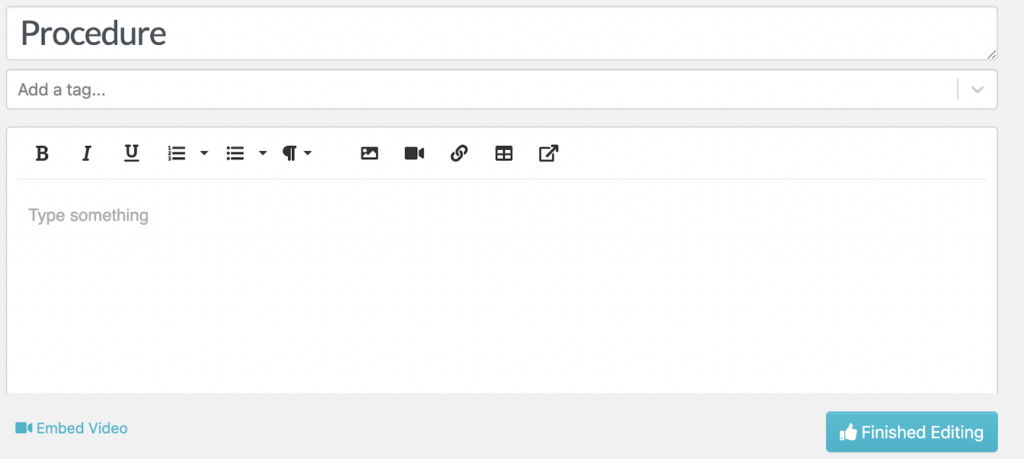
- Add tags using keywords. This makes it easy to identify or find your procedure.
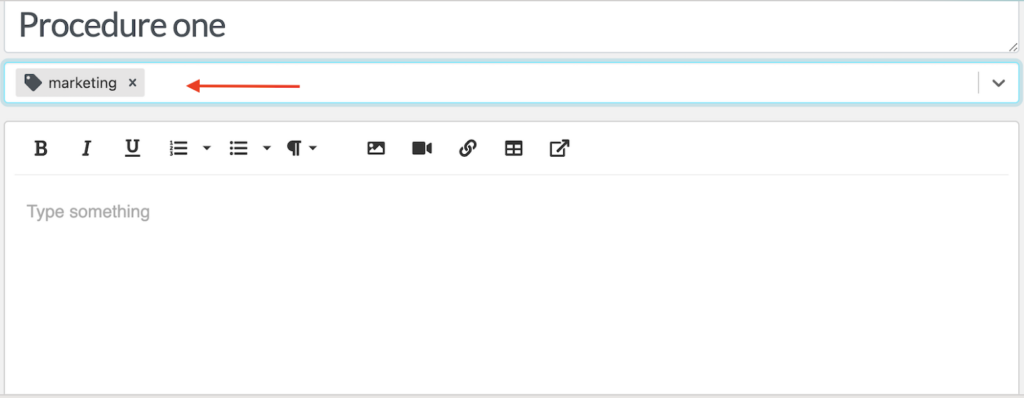
- Tap the “Step” button to edit your steps.

- Include a title and description for your step.
- You can embed images and videos or add a link to the step.
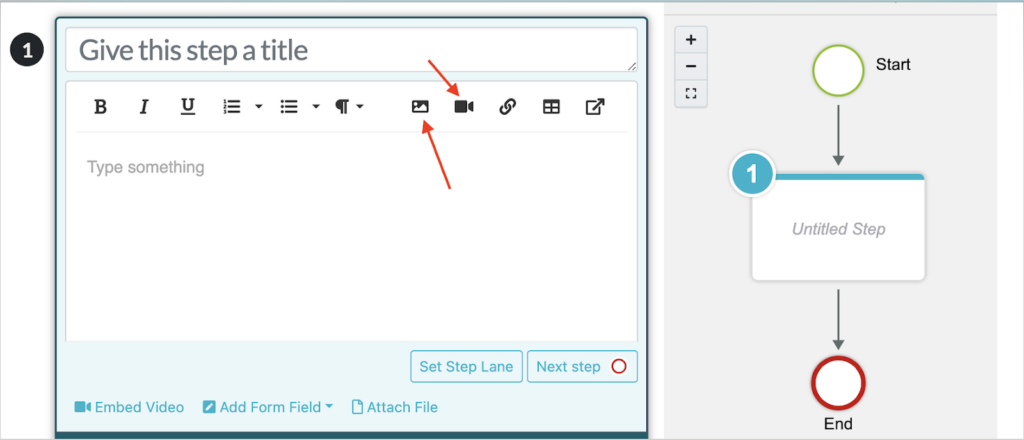
Once you are done editing, click “Finished Editing.”
To add more steps, follow the same procedure until you’ve added all the necessary information. Once all the details are included, tap the “Approve” button and your procedure will be live on SweetProcess.

Several companies have used SweetProcess to document their procedures. One of them is the managing director at All Residential Real Estate, Perry Beebe. The real estate industry was constantly changing; therefore, Perry needed to regularly update the business. However, the company had outdated paper-based checklists that did not meet the company’s needs.
Because of this, the employees lacked key information to execute their tasks. Perry started looking for paperless documentation software to streamline the company’s operations, leading him to SweetProcess. Thanks to this move, the company now has proper procedures, onboarding has become more streamlined, and the operations are consistent.
Another beneficiary of SweetProcess is Dr. Jeremy Weisz, the co-founder of Rise25. Jeremy and his team designed and documented procedures on platforms like Google Docs. However, this became ineffective because the employees could not execute their tasks without consulting Jeremy.
This prompted Jeremy to seek an alternative. Once he discovered SweetProcess, he could implement proper procedures. The company can now document all company information in a centralized place for all employees to access and execute their tasks.
How to Create a Procedure on SweetProcess using AI
Alternatively, you can use SweetAI to create your procedures in a few minutes.
Follow the same steps to create a procedure manually. After adding the procedure title, choose the option to write with SweetAI.

AI works in the background to write the procedure draft. This process takes less than 60 seconds. SweetAI automatically generates the description, steps, and a flowchart.
For instance, if you are creating steps on customer support, here’s an example of a procedure developed with SweetAI:
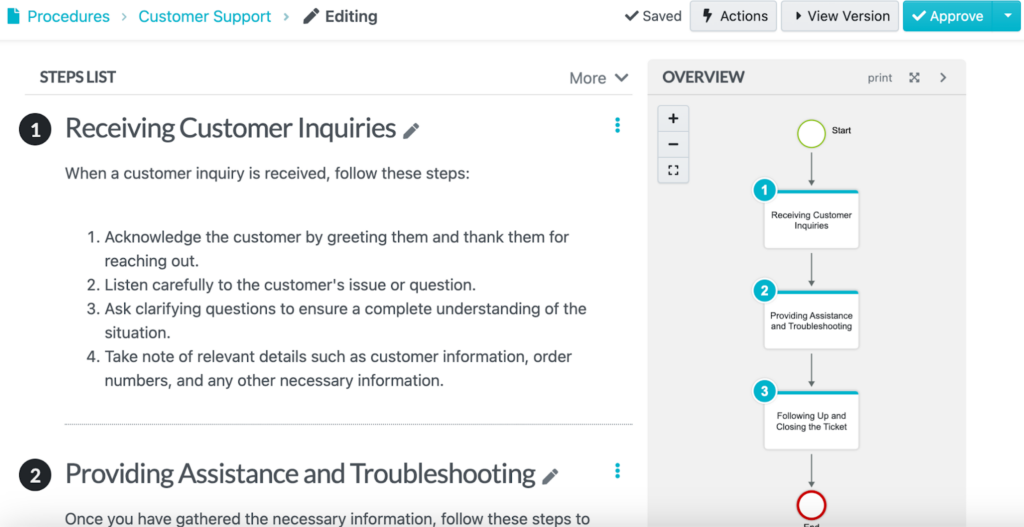
How to Manage a Procedure in SweetProcess
Once you create your procedures, you can easily manage them from the dashboard. To view all your procedures, click the “Procedures” tab on the main menu.

Select the procedure you need to edit, update, or delete.
5 Questions to Answer Before Writing a Procedure

Before you start creating a procedure, you need to ask yourself these questions:
1) Do I really need a procedure for this process?
Procedures will help you accomplish all your company processes. The procedure might be redundant if the process is routine, uncomplicated, and easily remembered. However, you must create a procedure if your process is complex, safety critical, or for regulatory tasks. For instance, if the process requires industry compliance, it might be necessary to create procedures to avoid missing necessary steps.
2) What is the purpose of this procedure/what do I want it to achieve?
Determine the specific objective: Is it for training, compliance, safety, or process consistency? Understanding the purpose guides the procedure’s structure and content.
For instance, statistics show that employees tend to waste more than 21 days annually doing repetitive tasks that could be easily automated. Therefore, if your team members are struggling with menial tasks, you need to define the procedure’s purpose clearly. Defining the purpose keeps the procedure focused on its intended function.
3) Is writing the best format for this procedure?
Consider the nature of the task and the audience. While written procedures are versatile, certain tasks might benefit from other formats.
Videos or interactive guides could be more effective for hands-on processes because they provide visual clarity. On the other hand, complex workflows might be better suited for flowcharts. Evaluating the task’s complexity and the audience’s learning preferences ensures the chosen format aligns with the procedure’s goals.
4) Is there an existing template to take a cue from?
Before starting from scratch, explore existing procedure templates within your organization or online resources. Choosing software with a pre-established template provides a structured framework, ensuring consistency across procedures.
Additionally, it saves time and effort by offering a reliable starting point. You can tailor a proven template to fit your needs within a few hours.
5) Do I have all the information I need to write this procedure?
Thoroughly assess whether you have all the company details before you start creating. You can gather information from team members, experts, and other leaders to make the process comprehensive.
Insufficient information can lead to vague or inaccurate instructions. Therefore, it’s important to check that you have added all the safety protocols, tools, and steps. This is the only way to ensure the procedure is thorough, accurate, and beneficial to its users.
What to Do After Writing a Procedure

Your procedure is ready—now what? Here are the next steps to take.
Ask for Feedback and Update
After creating a procedure, actively seek feedback from users or stakeholders involved in the process. From their experiences and suggestions, you can improve the procedure to be better. Constructive feedback identifies gaps in the procedure, allowing you to enhance its clarity and effectiveness.
For instance, if you have developed an office protocol procedure, you need employees’ feedback. They are better positioned to provide additional troubleshooting tips that can help keep your procedure relevant and user-friendly. Additionally, your employees might be more open to the procedure when their contribution is included.
Measure the Success of Your Procedure
Apart from the feedback, you also need to evaluate the procedure’s effectiveness. Define clear metrics such as task completion time, error reduction, or user satisfaction surveys and analyze them regularly to gauge the procedure’s impact.
For example, in an onboarding process, your indicators of success can be reduced training time and increased new employee confidence. Measuring these outcomes allows you to identify strengths and areas for enhancement.
Examples of Procedures
Here are some examples of a procedure that can guide you to create one:
Example 1: customer inquiries
This is an example procedure for a company handling customer inquiries. The team needs to respond to inquiries promptly.
Introduction: This procedure outlines the approach to handle customer queries effectively over the phone. Our customer service representatives should follow these steps.
Resources
You’ll need the following:
- Phone system
- Computer
- Headset
- Knowledge base
Step-by-Step Procedure
- Greet the caller and answer promptly with a friendly greeting, stating the company name and your name.
- Listen actively to allow the customer to explain their query fully without interruptions.
- Repeat the query to confirm understanding. Ask additional questions if necessary to gather all relevant details.
- Offer clear, concise, and accurate solutions. Refer to the knowledge base if needed for detailed information.
- Address any concerns or objections politely.
- Summarize the solution offered and confirm if the customer is satisfied.
- Encourage them to reach out again if they have more questions.
- Record essential details, including the query, solution provided, and any follow-up actions needed.
- If necessary, initiate follow-up procedures, ensuring the customer’s issue is resolved.
- Thank the customer for their call, express gratitude for their business, and wish them a pleasant day.
Example 2: warehouse injury
This procedure example is for a manufacturing company. This procedure is followed when a team member gets injured in the warehouse.
Introduction: This procedure outlines the immediate response protocol in the event of an injury within the warehouse. Swift and appropriate actions are crucial for the safety and well-being of the injured individual.
Resources
- First aid kit
- Emergency contact list
- Communication devices
- Designated medical personnel
Step-by-Step Procedure
- Assess the situation to evaluate the extent of the injury.
- If severe, call emergency services immediately.
- If trained, provide necessary first aid within the scope of your abilities.
- Inform the immediate supervisor or manager about the incident.
- If the injury is serious, call for an ambulance, providing clear details about the location and nature of the injury.
- Prevent further accidents by securing the immediate area.
- Record essential details, including the time, nature of the injury, actions taken, and names of witnesses.
- Offer support and reassurance to the injured person while waiting for professional medical assistance.
- If local regulations require, report the incident to relevant authorities within the specified time frame, ensuring compliance with legal obligations.
Benefits of Well-Written Procedures in an Organization

Your company can benefit significantly by adopting the right procedure writing tools. Let’s look at some of these benefits.
Easier and Faster Employee Onboarding and Training
According to Zippia statistics, 21% of employers reported the onboarding process in their companies takes about a month. However, some companies take even longer due to poor procedures.
However, when your company has well-written procedures, new employees can grasp the essential tasks much faster. Clear, step-by-step instructions reduce learning curves because the information is well explained.
For instance, an ideal documented onboarding process might include setting up email accounts, accessing internal databases, and understanding communication protocols. New employees can integrate into the organization faster when all these details are readily available.
Improves Employee Efficiency
Confusion in the workplace can lead to financial losses. But with structured procedures, employees know what they need to do, minimizing errors.
For example, in a sales procedure, a clearly defined process for handling customer inquiries ensures sales representatives respond promptly, increasing customer satisfaction and potentially boosting sales. Invest in a procedure tool to boost the company’s overall organizational effectiveness.
Prevents Prevalence of Tribal Knowledge
As a business owner, you should delegate your duties to your team. The only way to ensure that everyone in the team knows the company’s task is by providing well-documented procedures.
When procedures are clearly outlined, employees don’t have to rely solely on undocumented practices or verbal knowledge from supervisors or managers. For instance, in IT troubleshooting, a detailed procedure ensures that all team members follow the same troubleshooting steps.
This consistency prevents information gaps and reduces dependency on specific individuals.
Ensure Consistency Across the Organization
To establish consistency, you need to craft standardized procedures. A uniform approach, whether it’s customer service protocols, financial reporting, or product development procedures, is necessary.
For instance, your customer service procedure should have consistent response strategies to ensure every customer receives the same level of service, enhancing brand reputation. This consistency fosters trust among customers and facilitates easier collaboration among teams.
Minimizes Risks and Mistakes
Well-crafted procedures act as safety nets, minimizing risks and errors by clearly outlining the correct methods and best practices.
For example, specifying a manufacturing procedure’s precise measurements and safety protocols reduces the chances of defects or accidents. Additionally, standardized procedures help in compliance, ensuring that legal and regulatory requirements are consistently met. This also reduces the organization’s exposure to risks.
Great Procedures Make Outstanding Businesses

Well-structured procedures are the cornerstone of outstanding businesses. They streamline operations, enhance employee efficiency, and ensure consistent, high-quality outcomes.
Incorporating a cloud-based tool like SweetProcess elevates this efficiency, providing a centralized platform for creating, managing, and sharing procedures effortlessly. Don’t miss out on the transformative power of well-documented procedures.
Start optimizing your processes today. Sign up for a free trial of SweetProcess and revolutionize your workflow efficiency. No credit card is required!
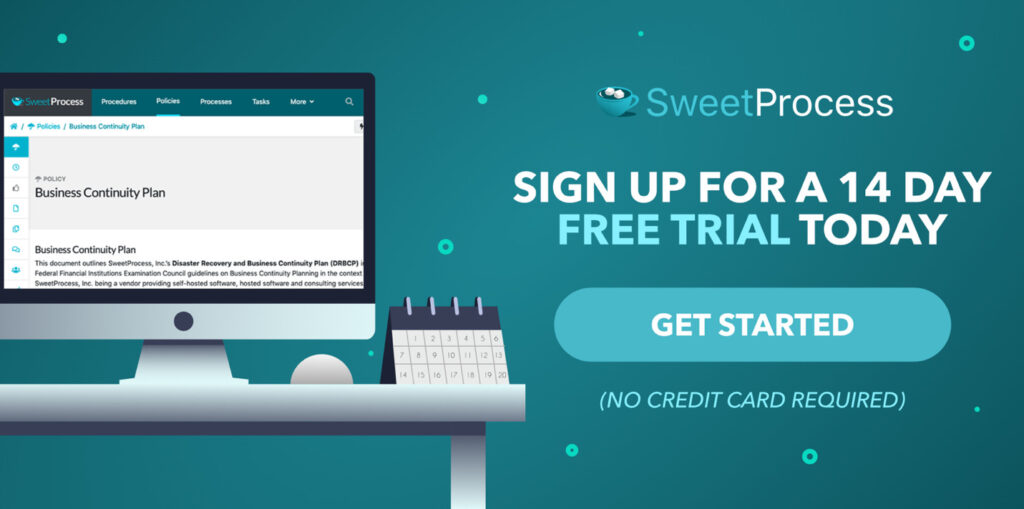




![9 Key Steps for an Effective Decision Making Process [+Examples] 9 Key Steps for an Effective Decision Making Process [+Examples]](https://www.sweetprocess.com/wp-content/uploads/2024/03/decision-making-process-150x150.png)

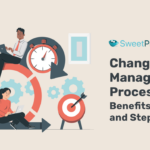


Leave a Reply